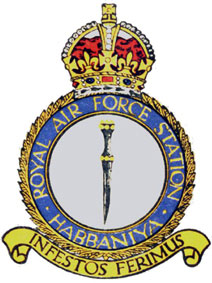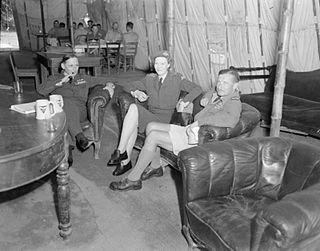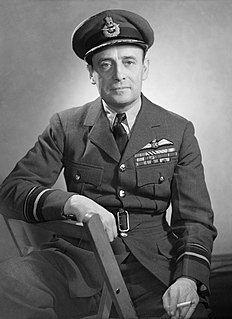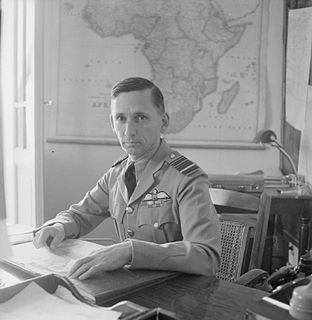Air Vice Marshal Alexander Gray, was a senior Royal Air Force leader during the Second World War.

The Anglo-Iraqi War was a British-led Allied military campaign during the Second World War against the Kingdom of Iraq under Rashid Ali, who had seized power in the 1941 Iraqi coup d'état, with assistance from Germany and Italy. The campaign resulted in the downfall of Ali's government, the re-occupation of Iraq by the British, and the return to power of the Regent of Iraq, Prince 'Abd al-Ilah, a British ally.

Royal Air Force Station Habbaniya, more commonly known as RAF Habbaniya, , was a Royal Air Force station at Habbaniyah, about 55 miles (89 km) west of Baghdad in modern-day Iraq, on the banks of the Euphrates near Lake Habbaniyah. It was operational from October 1936 until 31 May 1959 when the British were finally withdrawn following the July 1958 Revolution. It was the scene of fierce fighting in May 1941 when it was besieged by the Iraqi Military following the 1941 Iraqi coup d'état.

The Iraq Levies was the first Iraqi military force established by the British in British controlled Iraq. The Iraq Levies originated in a local Arab armed scout force raised during the First World War. After Iraq became a British Mandate, the force became composed mostly of Assyrians, Kurds and Iraqi Turkmen who lived in the north of the country, while the nascent Iraqi Army was recruited first from the Arabs who had joined the Iraqi Levies and later from the general Arab population (Beth-Kamala). Eventually the Levies enlisted mainly Assyrian soldiers with British officers. The unit initially defended the northern frontiers of the Province of Mosul when Turkey claimed the province and massed its army across the frontiers. After 1928 the prime role of the Levies was to guard the Royal Air Force bases located in Iraq.

Air Marshal Sir John Henry D'Albiac, was a senior commander in the Royal Air Force during the Second World War. Notably he was the British air commander for the Battle of Greece.
Iraqforce was a British and Commonwealth formation that came together in the Kingdom of Iraq. The formation fought in the Middle East during World War II.

Air Vice Marshal Amyas Eden Borton, was a pilot and commander in the Royal Flying Corps during the First World War and a senior commander in the Royal Air Force during the 1920s. He saw active service on the Western Front, in Palestine and in Iraq. In the latter part of his career, Borton was the second Commandant of the RAF College at Cranwell before becoming the Air Officer Commanding RAF Inland Area.

Air Chief Marshal Sir Robert Mordaunt Foster, was a Royal Flying Corps pilot in the First World War, and a senior commander in the Royal Air Force during the Second World War and the immediate post-war years.
Air Commodore John "Johnnie" Mortimer Warfield CBE RAF was a bomber pilot during the Second World War, a senior RAF staff officer and commander during the Malayan Emergency in the 1950s and, as an Air Commodore in his final tour, the ninth Commandant of the Royal Observer Corps.
The No.1 Armoured Car Company RAF was a military unit of Britain's Royal Air Force (RAF) based in Iraq and which played a role in the defence of RAF Habbaniya during World War II.

Harry George Smart, is best known for having been the commander of RAF Habbaniya during the first part of the Anglo-Iraqi War. Smart was an officer in the British Army, the Royal Flying Corps and the Royal Air Force. He served during the First World War, during the interwar period, and during the Second World War.

Royal Air Force Hinaidi or more RAF Hinaidi is a former Royal Air Force station near Baghdad in the Kingdom of Iraq. It was operational from 1922 until 1938, when operations were transferred to RAF Habbaniya.

Air Headquarters Malta was an overseas command of the Royal Air Force (RAF) during the Second World War. It was established on 28 December 1941 by renaming RAF Mediterranean under Air Vice Marshal Hugh Lloyd. Lloyd was named Air Officer Commanding in Malta on 1 June 1941.
AHQ Iraq was a command of the Royal Air Force (RAF).

Middle East Command was a command of the Royal Air Force (RAF) that was active during the Second World War. It had been preceded by RAF Middle East, which was established in 1918 by the redesignation of HQ Royal Flying Corps Middle East that had been activated in 1917 although a small Royal Flying Corps presence had been operational in the region since 1914.
Air Marshal Sir Paul Davie Holder, was a Royal Air Force officer who became Air Officer Commanding-in-Chief at RAF Coastal Command.
Air Marshal Sir Patrick Hunter Dunn, was a Royal Air Force officer who served as Air Officer Commanding-in-Chief of Flying Training Command from 1964 to 1966.
Air Vice-Marshal Robert Peel Willock, was a senior Royal Air Force officer who commanded the British Air Forces in Iraq during the Second World War.
Air Vice Marshal Thomas Audley Langford-Sainsbury, was a senior Royal Air Force officer who commanded British Air Forces in Egypt during the Second World War.

The RAF Armoured Car Companies were part of Britain's Royal Air Force (RAF) based in Iraq, Palestine and Transjordan. They were formed to operate with aircraft squadrons to suppress insurrection and maintain peace in the area in the aftermath of World War I.










